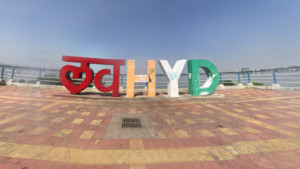Hyderabad Population 2025

| Year | Hyderabad Population |
| 1950 | 1,096,320 |
| 1955 | 1,178,673 |
| 1960 | 1,240,514 |
| 1965 | 1,460,111 |
| 1970 | 1,748,395 |
| 1975 | 2,085,893 |
| 1980 | 2,487,040 |
| 1985 | 3,209,443 |
| 1990 | 4,192,578 |
| 1995 | 4,908,133 |
| 2000 | 5,650,076 |
| 2005 | 6,521,705 |
| 2010 | 7,531,293 |
| 2011 | 7,751,240 |
| 2015 | 8,697,166 |
| 2020* | 10,004,144 |
| 2025* | 11,337,852 |
| 2035* | 14,151,724 |
Hyderabad Population in 2024 is 11.06 Million (1.106 Crore), population in 2022 is 10.6 million (1.06 Crore), and in 2021 is 10.2 million (1.02 Crore), Hyderabad has an average elevation of 500 meters above sea level. Hyderabad places and buildings reflects a blend of Hindu and Muslim styles. Many of the suburbs close to Hyderabad have been merged into the city after 2000, now called Greater Hyderabad. Popular and more populated places are central to hyderabad are Ameerpet, S.R. Nagar, Erragadda, Banjara Hills, Jublie Hills, Raj Bhavan, Somajiguda, Begumpet, Nampally, Charminar and Khairatabad. Popular places in the north side of Hyderabad are Sanathnagar, Bowenpally, Moosapet, Balanagar, Pathan Cheru, BHEL township and Chanda Nagar, Kukatpally, Lingampally and Nizampet. Places on the north-east side are Malkajgiri, Sainikpuri, Osmania University, Tarnaka, Habsiguda, Marredpally, Bowenpally, Trimulgherry, Secunderabad Cantonment Board and Uppal.
Hyderabad Population Ranking & Density
| Hyderabad City(2011) | Hyderabad UA(2020) | |
|---|---|---|
| Population | 7.7 million | 10 million |
| Area | 650 sq km | 7,257 sq km |
| Rank | 6 (India) | 34 (World) |
Religion wise Hyderabad Population
Hyderabad is home to many religions, Hinduism and Islam are the major relgions, According to 2011 census, Hindu population is 4.5 million, followed by 2.1 million with Muslim population. The Christians in Hyderabad are 192,660 people, 17,303 are Sikhs, 20,480 are Jain people and 2,451 are Buddhists.
| Religion | Persons | Percentage | Males | Females |
|---|---|---|---|---|
| Hindu | 4,540,841 | 64.93 | 2,324,389 | 2,216,452 |
| Muslim | 2,107,047 | 30.13 | 1,081,026 | 1,026,021 |
| Christian | 192,660 | 2.75 | 95,814 | 96,846 |
| Sikh | 17,303 | 0.25 | 9,117 | 8,186 |
| Buddhist | 2,451 | 0.04 | 1,319 | 1,132 |
| Jain | 20,480 | 0.29 | 10,458 | 10,022 |
| Others | 3,137 | 0.04 | 1,629 | 1,508 |
| Not Stated | 109,343 | 1.56 | 52,888 | 56,455 |
Source: 2011 Census: Language and Mother Tongue
Hyderabad Language demographics
Telugu and Urdu are the widely spoken languages of Hyderabad people. People from various parts of country have made the city their home, such as Gujaratis, Sikhs, Bengalis, Maharastians, Tamils, Kannadigas adn Coastal Andraites.
Disability
Below is the disable population stats of Hyderabad.
| Type of disability | Total Persons | Males | Females |
|---|---|---|---|
| In Seeing | 66,930 | 35,257 | 31,673 |
| In Hearing | 70,412 | 36,754 | 33,658 |
| In Speech | 28,077 | 15,990 | 12,087 |
| In Movement | 20,348 | 12,716 | 7,632 |
| Mental Retardation | 11,119 | 6,213 | 4,906 |
| Mental Illness | 3,235 | 1,876 | 1,359 |
| Others | 83,257 | 44,785 | 38,472 |
| Total disabled population | 294,072 | 159,490 | 134,582 |
Hyderabad Population age wise
According to Census 2011, the age group of 0-4 years, 304,736 are Male and 280,284 are Females. Between 5-9 years, 315,995 are Male and 293,816 are Females and between 20 to 30 years , 704,349 are male and 760,827 are females.
Hyderabad History
Hyderabad City was founded by the Qutub Shahi,the fifth king of the sultan of Golconda in 1591 with estimated population of around on the east bank of the Musi River. As on 1897 San Francisco call, the population in 1897 was estimated to be 415,039, fourth largest in India after Bombay(821,764), Calcutta(771,144) and Madras(452,518). The name Hyderabad was believed to have its earlier name "Bhagyanagar", named after Bhagmati, the mistress, Telugu courtesan of Quli Qutb Shah, But changing from Bhagyanagar to Hyderabad is unknown. A famous bangles market near to Charminar, also called Laad Bazaar, Products like siverware, Kalamari paintings, artivacts, silk and cotton ware have been traded in the city for centuries.
References
© 2019-2025 PopulationU, Research papers on Population dynamics and Social affairs, Contact | Privacy | About | Terms | 
